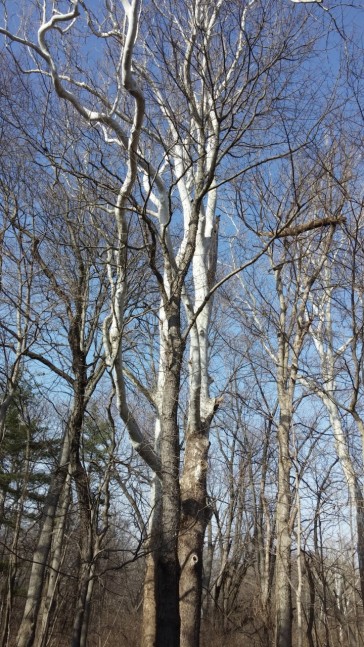Leaning forward, a fox peered over the edge of a massive rectangular hole cut deep into the earth. The dark gash would soon become the basement of a house about to be constructed a few hundred yards from my property. Just the previous day, foxes had wandered here freely, shielded by 60 foot sycamore, ash, maple, locust, and walnut trees in this small bit of wood they called home.

The fox looked puzzled, wondering. Its territory had been dwindling for some time—now, one more piece was obliterated.
For the seven years I lived alongside this forest remnant, I watched as it shrank piece by piece. Like taking bites out of a sandwich, the owner/developer sold chunks of this small forest land, making room for new homes. It was fast disappearing.
The wood behind my house was part of a tiny bit of forest land near Turkey Pen Creek, which flows west into Honey Creek in their journey to the White River (a wide, shallow waterway cutting straight through the city of Indianapolis).
Hugging the meandering paths made by these creeks, tiny remnants of old woods, bits and parcels really, like ours, persist among the roads and housing developments. Fox, deer, raccoons, rabbits, bobcats, beavers, badgers, coyote, mink, muskrat, skunk, turkey, and woodrats all once lived in these woods; they still dwell in Indiana’s larger forested areas. Just a few skirt from parcel to parcel now, though. Tiny copses, territory for a diminishing variety of animal life.
Seen from my back doorstep, the trees of “my” tiny wood formed a dense screen in the summer that seemed impenetrable. But this was only an illusion. The wood was thin, fragile, its life uncertain.
Still, I took great pleasure in this tiny remnant of Indiana woodland.
Of course, before we moved in, developers had removed other wildlings to make way for what would become my home. Indiana’s forest lands have long been disappearing.
According to the Indiana Department of Natural Resources (IDNR), “Indiana was more than 85% forest land (20 million acres)” before swelling human populations from the east overflowed into the territory in the early 1800s. The entering settlers chopped down the forest land’s most valuable “trees first–black walnut, yellow-poplar, black cherry, and white oak.” When these were gone, they removed the rest, and converted the cleared acreage into farms.
By 1903, only “7 percent of the original amount of forest land” (IDNR) remained.
In the last 100 years, groups have begun to remedy this. Both to protect biodiversity and to enable the harvesting of wood products, Indiana’s forested lands have made a comeback. Today, the IDNR says that nearly 21% of Indiana’s land is forested. Programs such as the Conservation Reserve Program (CRP), which has increased privately owned forest lands, have borne good results.
But overall Indiana’s forests—like others in surrounding states—face grave problems.
The remaining forests suffer from reduced diversity. Of the existing forest lands in Indiana today, “Timberland accounts for 96.7%,” according to the IDNR. Planted for harvesting, timber forests are less varied than old growth or reserved forests. Only 3.3% of the 21% is “reserved” forest land–in state and national parks, or federal wilderness areas.
And of both the timberland and reserved forest land, “41% is in unconnected fragments” (IDNR)
Tiny, scattered bits are generally all that is left of the great, diverse forests that once covered 85% of this state. This makes the few large swaths, like the forests in Brown County that I spoke about in my last post, invaluable, for fragmentation puts the entire ecosystem at risk.
While forest bits are better than no forests at all, forest fragments are less safe for flora and fauna and less healthy than big forest swaths. Fewer large trees survive in these tiny remnants. Animals are cut off from mates, breeding grounds, and food sources. Dissecting roads kill countless inhabitants. According to the World Economic Forum, forest fragmentation is the “primary driver of the global extinction crisis.”
 Forest fragments are also prone to further parcelization, as the wood behind my house illustrated. Fragmentation can lead to permanent land use changes, requiring more political activism to preserve what remains.
Forest fragments are also prone to further parcelization, as the wood behind my house illustrated. Fragmentation can lead to permanent land use changes, requiring more political activism to preserve what remains.
When I lived there, the wood behind my former home seemed tired, frail. One winter a great sycamore split down the center, two-thirds of the way to the ground, where it cracked off, tottered backward, and lay splayed. This was one of four large sycamore trees visible from our yard, and I grieved to see it go. Was its loss a freak of nature, or a sign of hidden decay? Would the others go soon as well?
Indiana’s trees face threats on multiple fronts. (The next post will describe other equally serious threats.)
Preserving forests for their own sake, for the animals’ sake; preserving them for our sake, for our children and for their children’s sake; preserving them for all they contribute to the nation and the world, behooves us.
For the sake of the wild woods… biodiversity… future foxes… we need to see ourselves as part of nature, for we’ll win for us all if we can work together to cherish the whole.

